UNCERTAIN OUTLOOK FOR PARKS
Concerns for the future
by TurfPro Editor, Laurence Gale MSC, MBPR
Having consulted fellow turf professionals, there appears to be a definite worry regarding the future recruitment of new blood into the industry.
My blog this week is really an update on what’s coming up in our industry and some thoughts regarding concerns facing us all moving into next year.
On Thursday this week (21st October) I will be attending the Amenity Forum conference at the Pirelli Stadium, home of Burton FC. Always a great conference with plenty of interesting speakers, this year’s final presenter will be Karl McDermott, head groundsman at Lord’s. Hopefully I’ll see some of you there?
Also, a reminder for you all to come and meet myself and the rest of the team from TurfPro and our sister title Service Dealer, at this year’s GMA Saltex at the NEC on the 3rd and 4th November. We have a stand at F109 so please call in during the two days of the show.
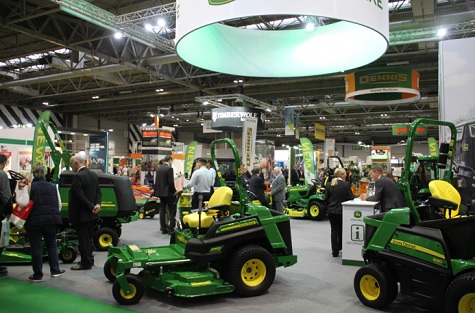
Parks excellence
As a Green Flag judge I was pleased to see the announcement that the Green Flag Award was presented to 2,127 parks and green spaces across the UK. It's another record-breaking year for the scheme which sees parks in England, Wales, Scotland and Northern Ireland meet the international quality standard.
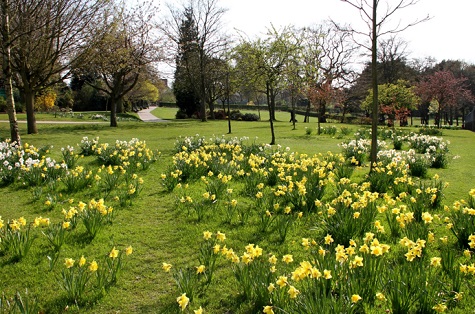
Alongside the parks flying the Green Flag Award, 349 spaces have achieved a Green Flag Award Community Award and 115 a Green Heritage Site Accreditation.
As the scheme marks its Silver Jubilee, four of the seven parks that received their first Green Flag Award when the scheme was launched in 1996 and have flown it every year since – Worden Park in Lancashire, Cockington Country Park in Torbay and Queen’s Park and Highgate Wood in London.
They are joined by parks and green spaces as diverse as the National Memorial Arboretum in Staffordshire, Scottish Power Renewables Whitelee Windfarm, Belfast Botanic Gardens and Bwlch Nant yr Arian in Ceredigion.
Green Flag Award scheme manager, Paul Todd said, “I would like to congratulate everyone involved in the 2,127 parks and green spaces on their achievement. To meet the requirements demanded by the scheme is testament to the hard work of the staff and volunteers who do so much to ensure that their site has high standards of horticulture, safety and environmental management and is a place that supports people to live healthy lives.”

While on the subject of Green Flag, I along with some other parks professionals will be talking about the state of public parks at this year’s GMA Saltex show. There is now plenty of evidence about the value of these public open spaces and what they bring to communities. A key issue facing parks managers and local authorities is securing the relevant funding to continue to maintain and manage them. For far too many years we have seen a spiral of decline in their management, mainly due to budgetary cuts and the fact that they are not recognised by government as a statutory service.
In total there are 398 principal (unitary, upper and second tier) councils in the UK – 24 county councils, 181 district councils, 36 metropolitan councils, and 124 unitary councils. There are around 11,000 local councils in the UK, from town councils to parish councils. These councils, along with several trusts, charities and other organisations, manage between them 27,000 public parks across the country and employ a significant number of professionals to manage and maintain them within such service areas including streetcare, waste services, leisure services, community services, neighbourhood services and cultural services. It is now a rarity to find an authority that retains its distinct ‘parks service’ as it has most likely been absorbed into a wider departmental structure. Yet public perception is very different, with many still perceiving that ‘parks departments’ exist.
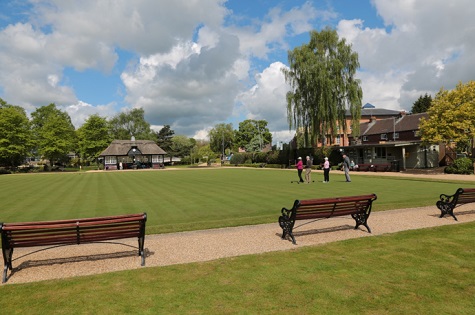
Future of the sector
Over the last 20+ years, there has been a significant reduction in the number of professionals dedicated to the management of parks and green spaces. Headlines such as ‘last of a dying breed’ have been seen not only in the trade press, but also in mainstream media. For me, along with many more ex and current parks managers, there is a real worry about the future of parks.
However, a recently formed organisation aptly named The Parks Management Association, set up by Paul Rabbits, who chairs the organisation, has as its sole purpose the promotion and support of parks managers and parks operatives.
Having spoken to many parks professionals and indeed many other horticultural and sports turf professionals, there is a worry about the future recruitment of new blood to come into this diverse industry. I have been lucky to have dedicated myself to the sector for over 50 years and still find it a wonderful, stimulating industry to work in.
To become a parks manager, or indeed hold a senior manager’s post in our industry, there is generally a requirement to have had some working life experiences of the job. There’s not many high-profile grounds managers / head greenkeepers in post who have not worked on the tools.
Back in my day we had parks apprenticeship schemes that ran for five years, enabling you to acquire the skills and experience required to become a professional horticulturalist.
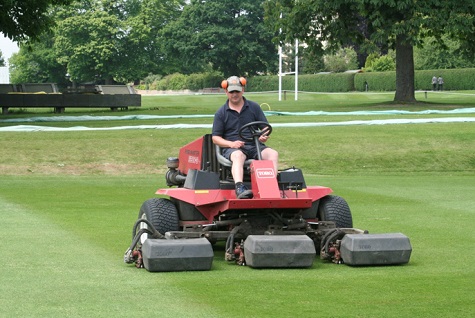
However, apprenticeship schemes are few and far between now and finding the right training provider / college course to suit your employers’ requirements is now often becoming more and more difficult.
Many professional sports clubs and golf courses are finding it difficult to recruit with one of the main stumbling blocks being pay and working conditions and the fact that Generation Z do not want to work long physical hours. Even with basic qualifications the pay scales are generally between £18-22k not what you would call a living wage by today’s expectations.
I personally think we are going to struggle to entice a new generation of horticulturalists, gardeners, and grounds professionals in the coming years due to the reason mentioned above. There needs to be a shift in attitudes, and we need to promote the many other benefits that come with working in our industry as well as finding a way of increasing pay and improving working conditions.
 |
|
 |  |
SALTEX REVEAL WHO'S IN THE ECO VILLAGE
Electric products on show
In our first WEB ONLY story, it's revealed how the dedicated area of the show floor will feature a programme of daily demonstrations of sustainable technology.
BTME BACK IN ITS NATURAL ENVIRONMENT
Registration now open
In our next WEB ONLY story, BIGGA has launched registration for its annual exhibition, which returns in 2022.
WELL KNOWN GREENKEEPER JOINS THE TEAM
At Infinicut
Infinicut have announced expansions to both their internal sales team and dealer network.
Infinicut have announced expansions to both their internal sales team and their dealer network.

Bobby McDougall
Taking up the role of territory sales manager for Scotland and the north of England is Bobby McDougall - a third generation greenkeeper and well-known name, having gained years of experience on both sides of the industry fence.
Bobby began greenkeeping in 1997 where he worked underneath John Coleman at Abbeydale Golf Club. After taking up a role in sales with Aitkens in 2009, he then moved more into the construction side, taking up a position with Souter Sports and then later joining dealership Fairways GM. In addition to the north, Bobby’s new role will also see him looking after Sweden, Norway and Southeast Asia.
“Having previously worked alongside John, we have remained in touch and I have naturally always followed the developments of both the Infinicut and TMSystem ranges. When the opportunity arose to come on board, it was an invitation I couldn’t turn down” explained Bobby.
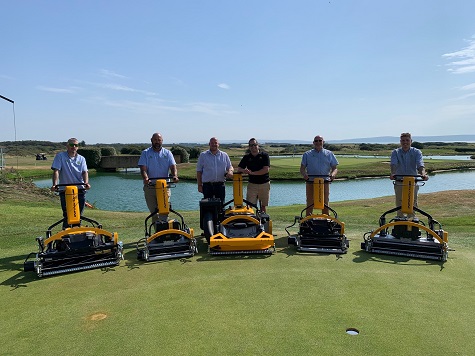
The team from Hunt Forest with Oliver Hall of Infinicut third from left
Also announced by Infinicut Hunt Forest Group are the latest name to be added to the company's dealer network, strengthening coverage across Hampshire, Dorset, Somerset and Wiltshire. Formed in 2019 following a merger between two John Deere dealerships, Hunt Forest offer a broad selection of franchises to meet the requirements of both agricultural and amenity customers.
Commenting on the news, Turf & Construction sales director, Ed Smales, said, “We are delighted to be working with Infinicur - it is a unique product that is well-built and has an excellent reputation in the market. The range is a fantastic fit alongside the JD brand and the rest of our existing portfolio, meaning we can now offer even more quality solutions to new and existing customers to satisfy their maintenance needs.”
Oliver Hall, Infinicut territory sales manager added, “Hunt Forest have a great reputation for sales and aftercare and across their depots will have factory trained technicians and a plethora of parts on the shelf to support customers in their area."
 |  |
CALEY THISTLE UPGRADE MOWER AFTER 19 YEARS
Trusty machine replaced
Head groundsman at Inverness Caledonian Thistle FC, Dale Stephen has taken delivery of a replacement mower after almost two decades of use.
Inverness Caledonian Thistle FC has said goodbye to its 19-year-old Dennis cylinder mower and welcomed a new G860 as its replacement.

Head groundsman Dale Stephen admits that it did not take much to convince Scot Gardiner, the CEO to buy the new machine - he simply had to look at the job his old one was doing. However, it could have been a quite different story and Dale admits that he was somewhat guilty of judging a book by its cover.
“When I first joined, I went into the tractor shed and looked at what machines and equipment I had to work with,” he said.
“There were only a handful of machines and there was this old Dennis G860 in the corner. The old groundsman at the time told me that it would be the best and most reliable mower, but I must admit, looking at how old it was, I thought he was joking.
“How wrong I was. From the first time I cut with it, I was hooked and wanted to use it all the time.”
Up until joining Inverness Caledonian Thistle, Dale had been a greenkeeper for the entirety of his career. He claims that moving over to the football side of grounds management was always part of his plan and was delighted when he was given the opportunity at Caley Thistle five years ago. It did not take him long to adapt and since joining the club, the pitch at the Tulloch Caledonian Stadium has frequently been held in high regard.
“People ask me how I produce a pitch like that,” said Dale. “But I think it can be as easy or as difficult as you want to make it. If you do the basics and do them well, then you are giving yourself a good platform to have the best surface you can. The right products and the right equipment will certainly bring out the best of the pitch.”
Dale says he has no doubt that his 19-year-old G860 could have continued cutting and preparing the pitch at the stadium but the perfectionist in him wanted a newer model. “I told the CEO (Scot Gardiner) that if we got a new G860 then it would be a good investment because it will more than likely outlast me!” he said.
Dale’s wish was granted, and it was not long before he was the proud owner of a shiny new Dennis G860.
“The main difference between the new one and the old one," says Dale, "is that I have an 8 bladed cylinder now and I have really seen an improvement.
"The finish is second to none and the sward has really thickened since using it."
 |  |
POSITIVE IMPACT ON FAIRWAYS
Head greenkeeper praises investment
The Herefordshire Golf Club head greenkeeper, Jeremy Browne, believes the arrival of new owners is proving to be most beneficial.
The head greenkeeper at Herefordshire Golf Club, Jeremy Browne, says he has seen many changes in the 31 years he has been at the club, but he believes the arrival of new owners is proving to be one of the most beneficial.
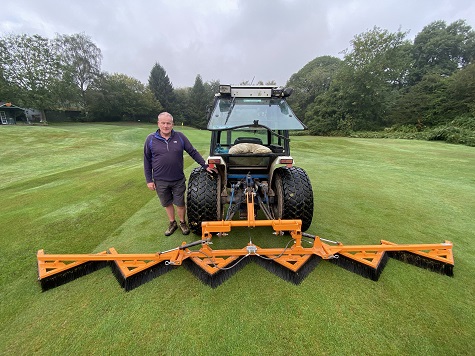
Jeremy Browne
“The new owners have come in and are really starting to make a difference,” he said. “They have invested in the clubhouse which is having a renovation; they are planning on introducing more drainage around the course and they are committed to investing in new equipment.
“I like repairing machinery but all the time I’m doing that, I’m not out on the course,” Jeremy continued. “I was delighted when the owners came to me directly and asked what I needed. I told them that to keep me out on the course, then I needed the most reliable equipment."
With fairways being his first port of call, and with an increasing amount of worm casts appearing, Jeremy narrowed his search down to two possible machines.
“We thought that the SISIS Flexibrush would be the better product for us,” he said. “With all the moving brushes it seemed to follow the contours and the undulations on the course a lot better than the alternative.
“Wormcasts was the main issue, obviously they smear when you are cutting and can be a bit of a nuisance,” said Jeremy. “With less chemicals now available, we must look at going back to more effective natural ways and the Flexibrush was the best solution because it can be used for multiple tasks.
“For example, in the winter when we are unable to cut the grass, we can use the Flexibrush to stripe and ensure that the fairways are nicely presented. We have also used the Fleixbrush to stand the grasses up before cutting because it provides us with a better finish; and it is great for knocking the dew off.
“The size and width of the machine are ideal,” continued Jeremy. “We can cover larger areas and it folds up so it can be stored nicely, and you can get through small gaps if needed."
 |  |
STANDARDS MAINTAINED
At Normanby Hall Country Park
Significant investment has been made over the past year by North Lincolnshire Council to the facilities and equipment fleet.
Adjoining Normanby Hall Country Park near Scunthorpe in North Lincolnshire, the beautiful 18-hole, par 72 golf course is set in 117 acres of mature woodland and parkland and is considered to be one of the best municipal courses in the country.
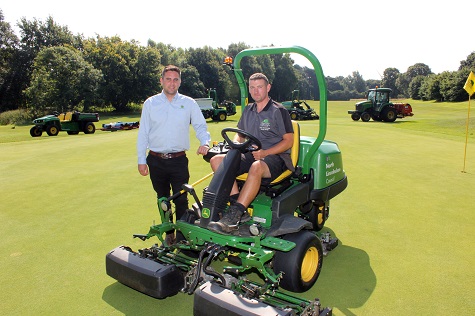
Simon Fountain of John Deere dealer Adamsons and Michael Burgin of Normanby Hall Golf Club
Significant investment has been made here over the past year by North Lincolnshire Council. Improvements to the course have included new tees, pathways and drainage, the installation of a three-bay covered driving range with additional practice facilities, and refurbishment of the clubhouse - as well as a new John Deere course maintenance equipment fleet supplied by local dealer F G Adamson & Son at Langworth.
Normanby Hall Golf Course senior greenkeeper Michael Burgin attended the first John Deere sponsored TPC Sawgrass volunteer programme in 2015, as a member of the Florida course’s maintenance team preparing for the Players Championship. Michael won the greenkeepers’ nearest the pin competition at the famous 17th hole and still has the signed flag to prove it.
Michael has been back to TPC Sawgrass as a volunteer every year since, and as he says, “Ever since my first trip there, I said this is the equipment that I want to be working with.”
The golf course is now being maintained immaculately by the new fleet, which includes a 2550E hybrid electric triplex greens & surrounds mower, 7700A PrecisionCut fairway mower, 9009A TerrainCut rotary rough mower, 2030A ProGator with Dakota top dresser attachment, HPX 815E and TE electric Gator utility vehicles and a 3046R compact tractor, plus a Tru-Turf R50-11 greens roller and Charterhouse Redexim Speed Brush.
“Having been promoted from assistant greenkeeper four years ago, I inherited a lot of equipment that was on its last legs and repair bills were mounting up,” says Michael. “The Council’s new management team had committed to maintaining and improving the course and its facilities, and ultimately investment in a new machinery fleet became a key part of this commitment.
“We went through a formal tender process in the end before reaching a final decision, essentially looking at value for money. Adamsons and John Deere won it by a country mile, ticking all the boxes for lead times, value, service and parts backup – all the criteria were more than met.
“We already had some older John Deere machines, including compact tractors, and had established an excellent relationship with the dealership, so Adamson’s depot manager Simon Fountain and I looked at various options and we came up with a list of what we needed.
“I knew I had to have specialist equipment for the greens, including a brush, top dresser and greens iron, to bring them up to the next level. Having our own top dresser has been a godsend, as we used to hire one in from the dealer just twice a year. Now we aim to top dress little and often, every two weeks or so, and we’ve already put on 40 tonnes of sand this year. It causes minimal disruption to play, but it’s made a huge difference to the standard of the greens.
“The after-sales service from Simon and the dealership has also been phenomenal, whenever I call they’re always available to sort out anything I need straight away.
“We’ve now gone back to over 350 members, and picked up over 100 since we reopened in March after the last lockdown. I believe this is primarily due to the fact that the course is in such good condition now, and word’s gone round. It’s come on phenomenally, we’ve definitely been able to step things up to a higher level since we got the new machines.”
 |
|
 |  |
ADVERTISE YOUR JOBS HERE
Amazing success rates!
Advertise your recruitment needs on TurfPro Weekly Briefing and reach our targeted audience of recipients every week.
Contact Nikki Harrison for details - 01491 837117
|
 |  |
EDITOR'S BLOG ARCHIVE
Catch up with Laurence Gale's recent blogs
Want to catch up with one of editor Laurence Gale's blogs? Here is the place to do so.
TURFPRO FEATURE ARCHIVE
Find our previous features here
If you want to catch up with any of TurfPro's previous features, here is the place to do so.
OVER 800 YEARS OF HISTORY
Johnstown Castle and Gardens
A CLUB GONE WILD
Kilkenny Golf Club
A GOLF COURSE IN THE GARDEN OF IRELAND
Woodenbridge GC
80 YEARS YOUNG
Charleville Golf Club
AN UPLIFTING EXPERIENCE
Bunclody Golf & Fishing Club
GETTING BACK TOGETHER
Albeit gradually . .
GO WEST
Inishturk GAA pitch – one of the most westerly sportspitches in Europe
WORKING ON A TIGHT BUDGET
Nenagh Golf Club
ON A MISSION
Wrekin Golf Club aiming to enrich wildlife and fauna
WILD AND WONDERFUL
Design By Nature
LEARNING HOW TO SURVIVE
Abbey Par 3
TACKLING OBESITY
Vital that schools can provide sport
A LIFETIME OF LEARNING
Vital for turf professionals
CELEBRATING 125 YEARS
Tullamore Golf Club
UNIVERSITY CHALLENGES
At Trinity College Dublin
BLENDING THE OLD WITH THE NEW
Bray Golf Club
A WELL POLISHED COURSE!
Ierne Social And Sports Club
IDENTIFYING THE TRUE VALUES
Of grounds maintenance
THE INDUSTRY WILL CHANGE & ADAPT
But it will survive
WIRRAL GOLF COURSES SAVED
Renewed hope and optimism for the future
GREEN SPACE CONTRIBUTION TO WELLBEING IS UNDERVALUED
Parks invisible on national agenda
A SHINING LIGHT IN IRELAND'S SUNNY SOUTHEAST
Wexford Golf Club
GREEN SPACES DO NOT LOOK AFTER THEMSELVES!
Keith Kent says we must invest in people
WE SHOULD TELL THE WORLD ABOUT THE UK INDUSTRY
Right time for all sides to come together
SOIL LIFE IS PRECIOUS
Good-quality soil can help save the planet
MORE THAN JUST CUTTING GRASS
Encouraging the next generation
A BUZZ FROM DOING THE JOB
Wide experience of the turf grass industry
PAYING THEIR WAY
Low wages is the bane of the industry
AMENITY MANAGEMENT IMPACTS US ALL
Professor John Moverley
CARING FOR PARKS OF ALL TYPES
Mary Worrall
TOP FIVE FRUSTRATIONS FOR CRICKET GROUNDSMEN
What causes you the most frustration in your role?
PROFESSIONALS AT THE CUTTING EDGE
Vic Demain and Phil Sharples
BOWLS CLUBS IN PERIL
A sad decline
A VERY SPECIAL INDUSTRY
Loz looks back
SNEAK PEAK AT A ROBOTIC "GAME CHANGER"
Commercial model capable of covering 50,000 m2 teased
HALESOWEN PICK A BIG ROBOT UP FRONT
Invest in mowers
COMPRESSED AERATION
The new way
PARKS MATTER MORE THAN EVER
Recent sector developments
ON TEST
STIHL blowers
THREE CORE VALUES TO SHAPE OUR INDUSTRY
Real concerns for the future
ENGLAND'S GREEN SPACE GAP
A split along racial lines
ON TEST
EGO STX3800 strimmer with RTX2300 Rotocut head
A SECTOR FACING IMPORTANT TIMES
Review of the National Action Plan
PARKS MATTER
The role of public parks in the recovery: a discussion paper
A UNIQUE SPORTING VENUE
Wormsley private estate
A BTME OUTDOORS?
A good bet for the industry
PARKS NEED APPROPRIATE POLITICAL REPRESENTATION
Q&A with Philippa Reece, Parks and Foreshore Manager at Adur and Worthing Council
CRICKET LOAM
What does it mean?
A HERCULEAN EFFORT TO GET PARKS BACK TO NORMAL
Q&A with Chris Worman, Rugby Borough Council’s parks and ground manager
ON TEST
STIHL battery products
TURFGRASS STRESS MANAGEMENT
Reactive Oxygen Species (ROS) and antioxidants during biotic and abiotic stress in turfgrass plants
AUTUMN DISEASE MANAGEMENT
The coming months are going to prove very difficult
THE ABUSE OF PARKS . .
Is the abuse of society
WHY PARKS MATTER?
A statement from the Parks Management Forum to the Prime Minister
THE 21st CENTURY PARKS MANAGER
Innovative, creative and entrepreneurial
EAT, SLEEP, CUT, REPEAT!
Cricket under covid
TIME FOR A SINGLE SHOW?
Debate brought back into focus
A CHALLENGING TWO MONTHS
Running golf design projects from home
PRESSURE SITUATION
Cementing the reputation
A CLUB TO BE PROUD OF
10 years at the helm of Olton GC
GAME CHANGERS IN TURFCARE
The day the Lord's outfield reconstruction proved its worth
THE ESSENCE OF ESSENTIAL
Finding a sensible way forward on defining "essential maintenance"
THAT WAS THE YEAR THAT WAS
2001
HOW TO LOOK AFTER A GOLF COURSE WITH NO GOLFERS
Fundamental to the survival of almost all courses, if not of the game itself
RAIN STOPPED PLAY WOULD BE WELCOME
. . along with ‘lunch is being taken early’
PHYSICAL CONTROL OF TURFGRASS PESTS
An urgent problem
A DIVERSE & ENTERTAINING WEEK
Successful BTME 2020
INTEGRATED PEST CONTROL
Opportunity to embrace new methods
ENVILLE ON THE UP
Major investments taking place
GREEN FLAG AWARDS 2019
A great success
U.S PROFESSIONAL EQUIPMENT SHOW EXCELS
Buoyant GIE+EXPO
LEGACY OF THE SOLHEIM CUP
At Gleneagles
A DAY OUT WITH THE LADIES
Behind the scenes at the Solheim Cup
COVENTRY UNIVERSITY'S EDIBLE GARDEN SUCCESS
2006 - present
HAIL THE GRASS MASTERS!
Boorish media comments about pitch quality are wide of the mark
CONTRACTOR SEES MULTI-DISCIPLINE SUCCESS
360 Ground Care serving professional facilities
BUSY TIMES
Judging the Green Flag Awards
TAKING AN INTEGRATED APPROACH
What does it all mean in managing turf surfaces?
UNDER PRESSURE
Dry weather conditions continue to keep turf managers focused on moisture management
EDDIE SEAWARD
Death of Wimbledon’s influential grounds manager
MAJOR NEW IRRIGATION PROJECT
At Top 100 classic Berkhamsted Golf Club
NEW HORIZONS FOR THE HATTERS
Investment paying off at Kenilworth Road
ELIZABETHAN RESTORATION
At Castle Bromwich Hall Gardens
WHAT IS BIOPHILIA?
The vital impact of parks and green spaces on health and well-being
WORM CONTROL
Without carbendazim
THE TRUE COST OF PETROL
Battery-powered outdoor power tools are now turning the heads of professionals
SANDS OF TIME
Sand-based pitches are now the norm in professional sports
WHY DO WE DO THE RIGHT THING?
We must maintain industry standards
CHASING GRASS PERFECTION?
11 things you need to know . . .
MAINTAINING STANDARDS
Q&A with BASIS ceo, Stephen Jacobs
STRI RESEARCH DAY 2018
Hosted at research trial grounds in Bingley
THE MECHANIC
Leicester City FC invest in new role
LORD'S 'GRASS-GUVNOR' TO RETIRE
Mick Hunt bows out after 49 years
HOLLOW CORING & DEEP SCARIFICATION
Is it really necessary?
 |
|
 |  |
 |  |
 |  |
 |  |
LONG POLE BATTERY HEDGE TRIMMERS TESTED
STIHL HLA 66 and HLA 86
by Laurence Gale, TurfPro editor
Myself and some professional colleagues, recently put STIHL's latest long pole battery hedge trimmers to the test in a variety of real-world, commercial conditions.
I have recently spent time testing the new STIHL HLA 66 and HLA 86 long pole battery powered hedge trimmers. I’ve used them in various hedging scenarios as well as asking work colleagues to also try them out.
The HLA 66 and HLA 86 are the latest models in the company’s range of long pole battery hedge trimmers, replacing the old HLA 65 and HLA 85 models respectively.
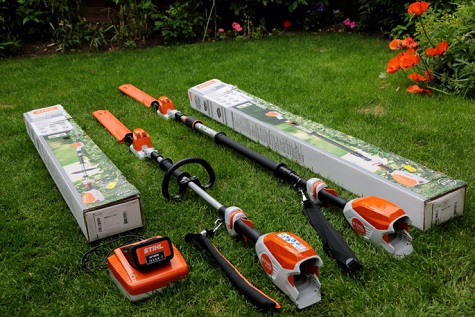
Both new models come with innovations and redesigned ergonomics intended to make them easier and safer to use. Emphasis is placed on the new design of the battery case which is housed more centrally on the shaft of the hedge trimmer to help distribute the weight of the battery and balance up the machine. There are also improvements to the reconfigured trigger, making it easier to operate whether you are right or left handed.
First up for testing was the HLA 66 lightweight (3.8kg) long pole hedge trimmer.
STIHL have restricted the weight of the machine to under 4kg, making it easier to handle and you can adjust the loop handle position for better comfort and control.
Using the AP 200 battery gave me enough power and lasted long enough to complete most of the tasks we encountered before needing to recharge.
On both models the working head can be folded back on itself for easy moving and storage and the 50cm double blade enables efficient cutting strokes when cutting hedges.

Both models have ring fittings to attach to shoulder harnesses if you want some extra support. As you can see from the above photographs, there are few controls to worry about, other than the power trigger, head adjustment and on the HLA 86, the opportunity to extend the operating length of the trimmer. It is essentially a case of inserting the battery, setting the angle of cutting head and then operating the trigger switch.
I personally liked the HLA 66 as it is more user friendly than the HLA 86 in terms of handling and versatility. It would be more of a general hands-on hedging tool to compliment my regular go to HSA 56 C-E petrol hedge trimmer, or, if I had one, a HSA 66 cordless battery hedge trimmer.
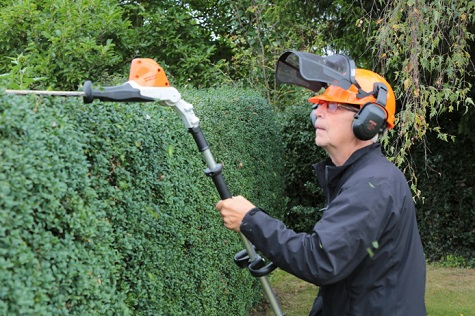
I would say the HLA 86 is a good complementary tool for taller hedges and has its place in a contractor’s set of hand tools, especially if they were doing a lot of regular hedging work.
I found it OK to use in shorts sessions, however, once you have extended it to its maximum length, it then tends to become more difficult to handle and operate, especially in terms of how long you can physically hold and use it. I soon got fatigued after 15 minutes. Having said that, like most tools, if you are using them on a regular basis, you soon get used to its feel and it becomes the norm. One option is the STIHL RTS harness which takes the weight of the tool and spreads it across your shoulders and waist, so your arms are just doing the positioning.
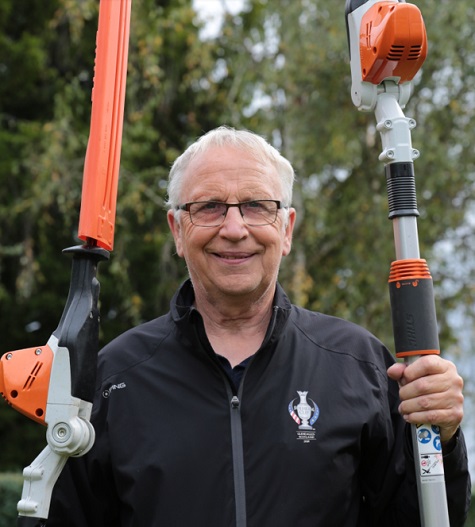
As for clipping speed, they both operate adequately well at 3000 rpm and produce a clean sharp cut through a variety of hedging materials. During the trials we used both machines on some box hedging, Conifer, mixed fields hedge, holly, privet and purple plum.
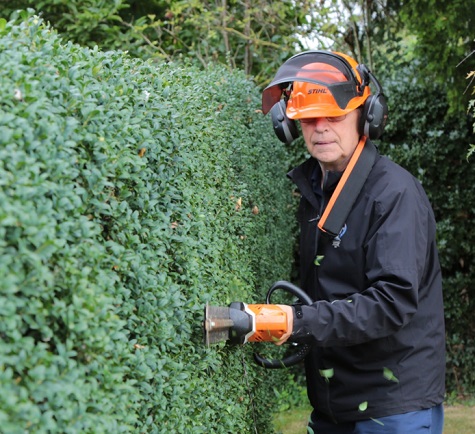
Regarding performance, both hedge trimmers had plenty of torque and power to cut through most types of hedging material.
To ensure I was not biased about the performance of these hedge trimmers, I arranged for a number of friends and colleagues to try them out under different working conditions.
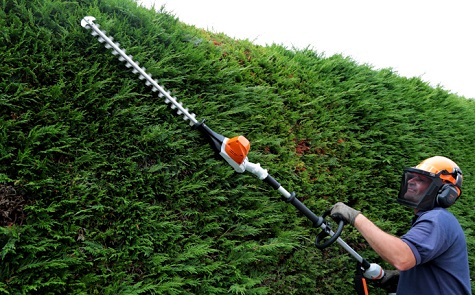
First up was a fellow turf professional, John Breeze, who kindly cut a large conifer hedge and said he found the HLA 66 ideal for giving him the finish he required. It also allowed him to cover more area without the need to use step ladders. He was impressed with the power of the hedge trimmer and its easy operating on and off switch. He also commended it on its durability and robustness.
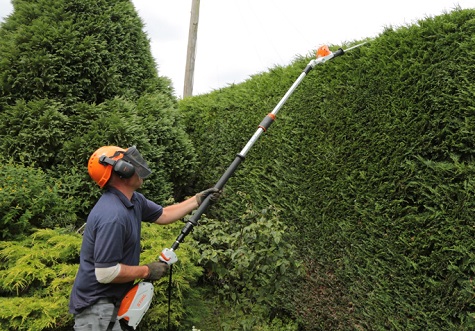
John was also keen to try the long HLA 86 on a purple plum tree and managed to reduce the crown quite easily without the use of any steps.
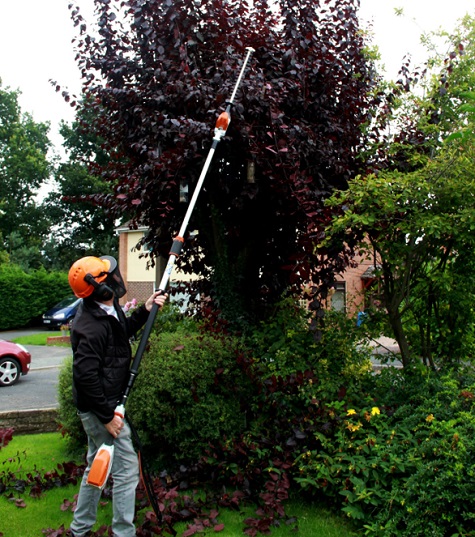
Next up was Rob Forrester, a gardener who trialled both the HLA 66 and HLA 86 on some of his field hedges. Again he told me he was impressed with the build quality, ease of use, the power of the tools and the longevity of the battery life.
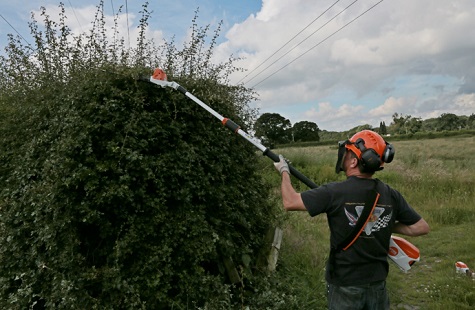
He was also keen to try out the HLA 66 to cut some vegetation at the base of the hedge. In his eyes he found it a versatile tool.
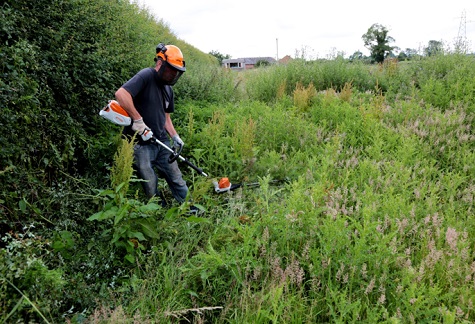
Finally, Kyle Lait a landscape gardener, wanted to try out both machines on his large privet hedges. Kyle said he was impressed with both hedge trimmers’ power and battery performance and thought both machines complemented themselves well, making the job of cutting hedges more efficient.
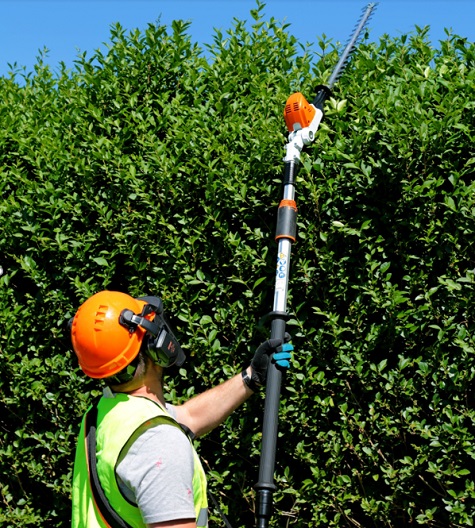
In general, we all were impressed with the ergonomics and design of the hedge trimmers and pleased with their performance in terms of power, cutting ability and robustness.
The other key point to mention was the reduced noise and vibration levels when using these two machines, compared to petrol driven machines.
Using STIHL’s AP 200 battery as the power source, we found it to be accommodating and quick to recharge, taking less than 40 mins, and it can be used in both machines. If you want further power options the manufacturer provides the AR 3000 L and AR 2000 L Backpack Batteries plus a carrier.
The Lithium-Ion backpack battery offers the professional gardener high power and long life. Including a USB connection and a Bluetooth interface for connection with STIHL Connected, the batteries are protected inside a sturdy housing and offer user-friendly features including an integrated carry handle and a six LED charge-level indicator. To maximise performance a weatherproof coating allows for use even in the rain and is tested to IPX4 standards.
As for cost, the HLA 66 based on current costs with no batteries included, comes in at around £300 while the HLA 86 is about £425. Choice of battery power will be dependent on work load requirements. I found, as a general landscape gardener, two AP200 batteries and a fast charger was sufficient for my needs - however, a contractor may want the option of the AP300 batteries or indeed go for a backpack AR 3000 L system.
The cost of both hedge trimmers, HLA 66 and HLA 86, with a selection of both single AP 300 and a backpack system would cost around £2200 – a substantial investment, but that does include the running costs. If you were to invest in petrol driven hedge trimmers, then you’d have the constant need to buy fuel - and at £20 for 5 litres it soon becomes a no brainer to convert to battery powered products. And this will of course become the norm in a few years’ time anyway, as petrol driven machinery is legislated out of use.
 |
|
|
|